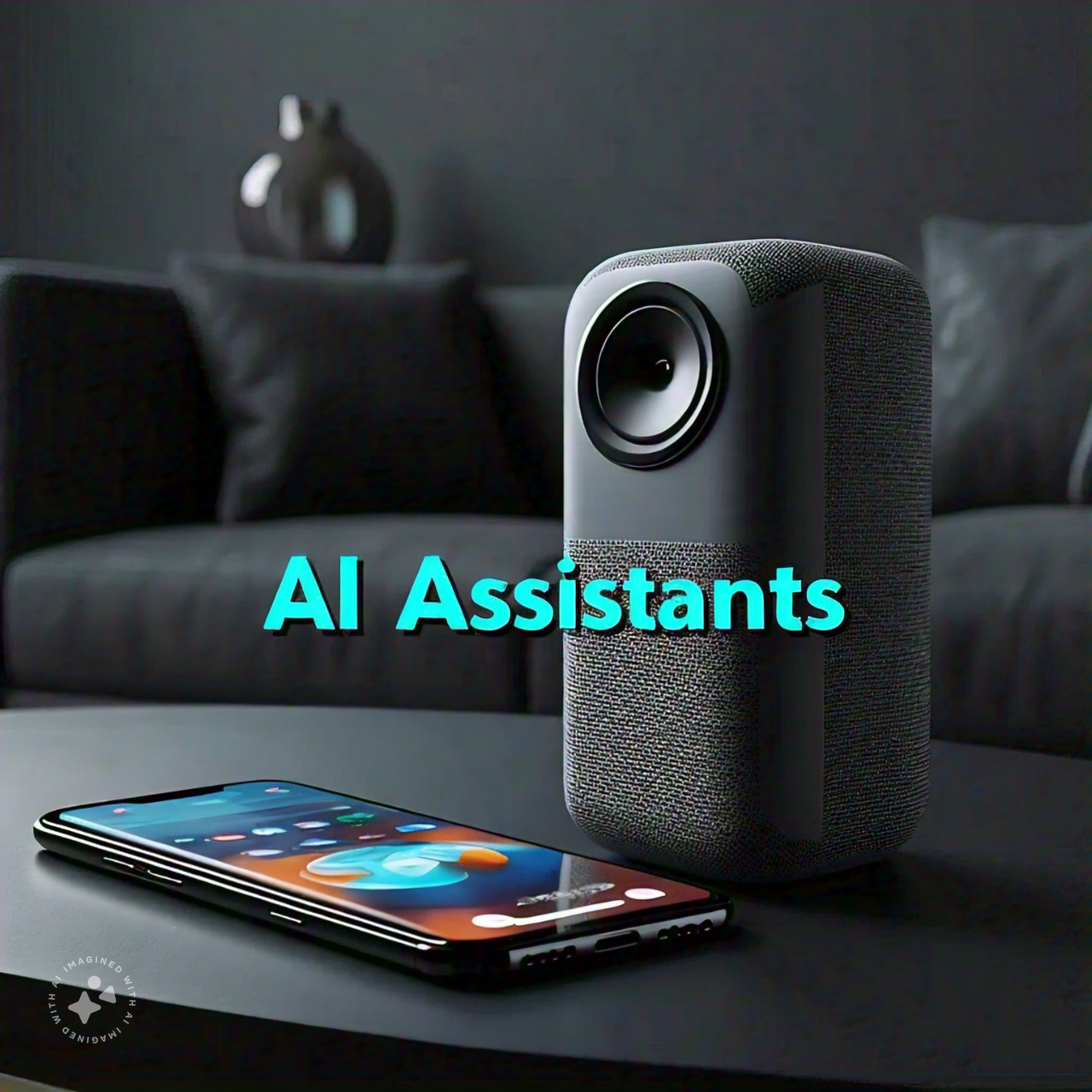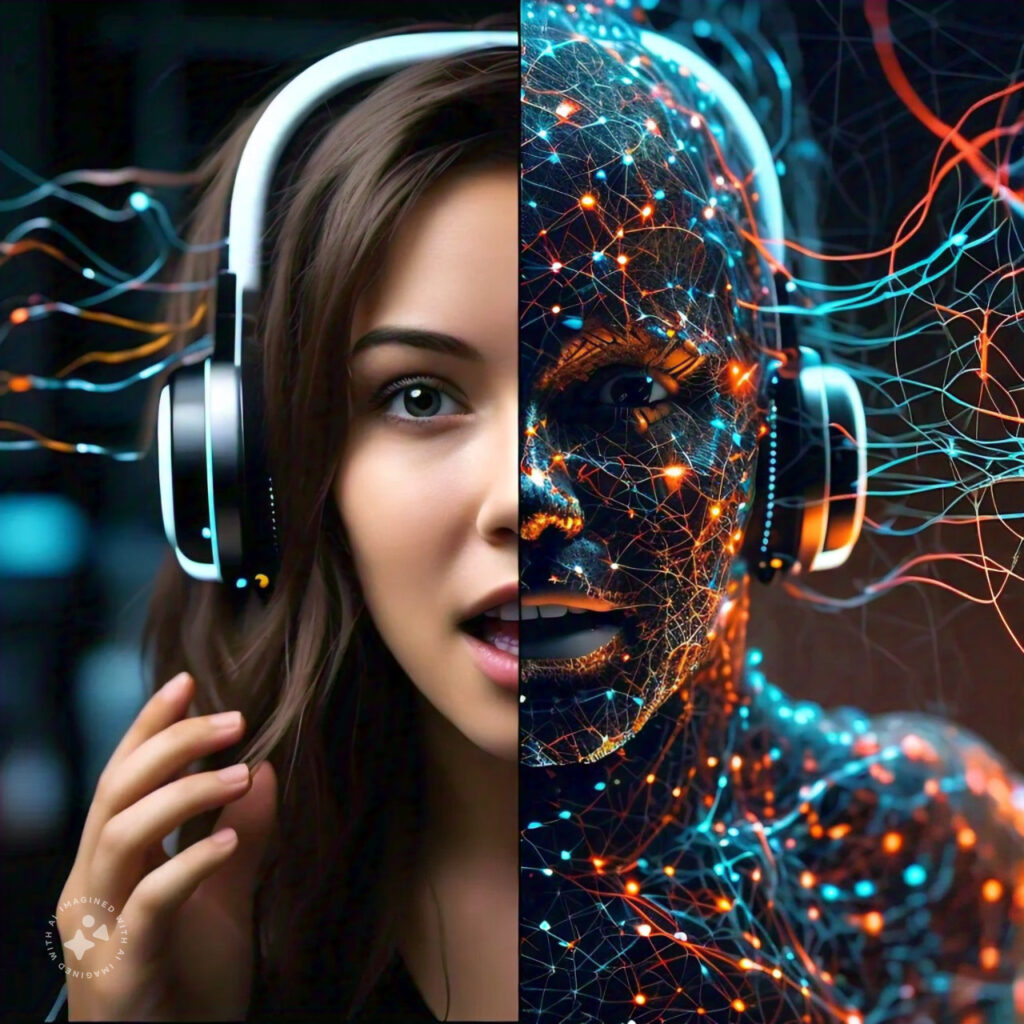
AI Assistants! Imagine a world where your every command is instantly understood and executed by an invisible, intelligent companion.
This isn't a scene from a futuristic movie – it's the reality we're living in today with AI assistants. But how did we get here?
 Caption: AI assistants: Seamlessly integrated into your life - Simplifying tasks and enhancing your everyday experiences.
Caption: AI assistants: Seamlessly integrated into your life - Simplifying tasks and enhancing your everyday experiences.The journey of AI assistants from science fiction to our everyday lives is a testament to human ingenuity and technological progress.
The concept of intelligent machines assisting humans dates back to ancient myths, but it wasn't until the mid-20th century that
serious scientific efforts began to turn these dreams into reality. The first significant milestone came in 1966 with ELIZA,
a computer program that could engage in conversation using pattern matching and substitution methodology MIT Technology Review, 2022.
As AI assistants become increasingly sophisticated, are we approaching a future where the line between human and machine intelligence blurs?
What ethical considerations should we be addressing now?
In 2016, a woman in New Mexico found herself in a life-threatening situation when her boyfriend allegedly threatened her with a gun.
Unable to call for help directly, she whispered to her Amazon Echo, "Alexa, call 911." While Alexa couldn't make the call at the time,
this incident sparked a crucial conversation about the potential life-saving capabilities of AI assistants NBC News, 2017.
AI Assistants: Usage and Market Statistics
AI Assistant Market Share
AI Assistant Usage by Task
AI Assistant Adoption Over Time
AI Assistant Features Comparison
Feature
Siri
Google Assistant
Alexa
Cortana
Voice Recognition
✓
✓
✓
✓
Natural Language Processing
✓
✓
✓
✓
Smart Home Integration
✓
✓
✓
✗
Third-party App Support
✓
✓
✓
✓
Multi-language Support
✓
✓
✓
✓
From the first rudimentary chatbots to today's sophisticated virtual assistants, the evolution of AI has been nothing short of revolutionary.
In 2024, we stand at the precipice of a new era in human-machine interaction. According to recent statistics, the global AI market is projected to reach
a staggering $407 billion by 2027 Forbes Advisor, 2024, highlighting the rapid growth and integration of AI into our daily lives.
Key milestones in this journey include the launch of Siri by Apple in 2011, followed by Google Now in 2012, and Amazon's Alexa in 2014.
These assistants marked a significant leap forward in natural language processing and voice recognition technology.
Today, we're witnessing the rise of even more advanced AI, with ChatGPT garnering an astonishing 1 million users within just five days of its release Forbes Advisor, 2024.
But the evolution doesn't stop here. Microsoft's head of AI, Mustafa Suleyman, recently announced that AI assistants with "really good long-term memory" are just a year away BBC News, 2024.
This development promises to usher in a new age of "persistent" AI tools that could revolutionize how we interact with technology.
As we delve deeper into this fascinating journey, we'll explore how AI assistants have transformed from simple voice-activated tools to
complex systems capable of understanding context, learning from interactions, and even anticipating our needs.
Join us as we unravel the past, present, and future of AI assistants, and discover how they're reshaping our world in ways we never imagined possible.
Understanding AI Assistants
 Caption: The power behind the voice: AI assistants - Uncover the complex technology that enables seamless interactions.
Caption: The power behind the voice: AI assistants - Uncover the complex technology that enables seamless interactions.A. What is an AI assistant?
An AI assistant is a software program that uses artificial intelligence to understand and respond to human commands or questions.
These digital helpers leverage advanced technologies like natural language processing, machine learning, and deep learning to interpret user inputs and provide relevant outputs or actions.
According to a recent study by Juniper Research, the number of digital voice assistants in use is projected to reach 8.4 billion by 2024,
surpassing the world's population Juniper Research, 2024. This staggering figure underscores the growing ubiquity of AI assistants in our daily lives.
AI Assistants: A Visual Guide
What are AI Assistants?
AI-powered software that understands and responds to human commands or questions.
Types of AI Assistants
Virtual assistants, smart speakers, voice assistants, and AI chatbots.
Popular AI Assistants
Siri, Google Assistant, Alexa, and Cortana are among the most widely used.
Time-Saving Benefits
AI assistants can automate tasks, saving up to 40% of time on routine activities.
Improved Organization
Manage calendars, set reminders, and prioritize tasks for better productivity.
Enhanced Accessibility
AI assistants provide hands-free operation and support for users with disabilities.
Privacy Concerns
Data collection and storage practices raise privacy issues. Use privacy settings to control data sharing.
Future of AI Assistants
Expect more personalized, context-aware, and emotionally intelligent AI assistants in the future.
B. Types of AI assistants
- Virtual assistants
Virtual assistants are AI-powered software applications that can perform tasks or services for individuals.
They're designed to understand natural language and execute a wide range of commands.
A prime example is Apple's Siri, which has been shown to handle over 25 billion requests per month Apple Newsroom, 2023.
This statistic highlights the integral role virtual assistants play in modern smartphone usage.
- Smart speakers
Smart speakers are voice-activated devices that use AI to respond to commands, play music, control smart home devices, and more.
They've become increasingly popular in recent years.
According to a report by Voicebot.ai, smart speaker ownership in the U.S. reached 35% of adults in 2022 Voicebot.ai, 2023.
This represents a significant penetration of AI technology into American households.
Key Insights: AI Assistants
The Rise of AI Assistants
AI assistants have become an integral part of our daily lives, with global usage skyrocketing in recent years. According to recent statistics:
- Over 4 billion devices worldwide now have AI assistants installed
- The AI assistant market is projected to reach $12 billion by 2025
- 85% of customer interactions are expected to be handled without a human agent by 2025
This rapid growth highlights the increasing reliance on AI technology in both personal and professional spheres.
+
Key Features of Modern AI Assistants
Today's AI assistants are equipped with a range of sophisticated features:
- Natural Language Processing (NLP) for understanding context and intent
- Machine Learning capabilities for continuous improvement
- Multi-modal interactions (voice, text, and visual)
- Integration with smart home devices and IoT ecosystems
- Personalization based on user preferences and behavior
These features enable AI assistants to provide more accurate, personalized, and efficient assistance across various tasks and domains.
+
The Future of AI Assistants
The future of AI assistants looks promising, with several exciting developments on the horizon:
- Enhanced emotional intelligence for more empathetic interactions
- Improved context awareness for more natural conversations
- Integration with augmented reality (AR) for immersive assistance
- Advanced predictive capabilities to anticipate user needs
- Increased focus on privacy and security measures
These advancements are expected to make AI assistants even more integral to our daily lives, revolutionizing how we interact with technology and manage our tasks.
+
- Voice assistants
Voice assistants are AI systems that use voice recognition to understand spoken commands and questions. They can be found in smartphones, cars, and other devices.
Google recently announced that its voice assistant now supports over 30 languages and is available in more than 90 countries Google AI Blog, 2024.
This global reach demonstrates the widespread adoption and versatility of voice assistants.
- AI chatbots
AI chatbots are computer programs designed to simulate human conversation through text or voice interactions.
They're commonly used in customer service, e-commerce, and information retrieval.
A study by Gartner predicts that by 2025, AI chatbots will handle 95% of customer interactions Gartner, 2024.
This forecast suggests a significant shift towards AI-driven customer service in the near future.
Each type of AI assistant serves unique purposes and continues to evolve, offering increasingly sophisticated and
personalized experiences for users across various platforms and devices.
How AI Assistants Work: An Interactive Timeline
Boosting Productivity with AI Assistants
In today's fast-paced digital world, AI assistants have become indispensable tools for enhancing productivity across various industries.
Let's explore how these intelligent helpers are revolutionizing task management, information retrieval, and overall efficiency.
 Caption: AI-powered doctor: A doctor using an AI assistant to review and analyze patient data, leading to improved diagnosis and treatment recommendations.
Caption: AI-powered doctor: A doctor using an AI assistant to review and analyze patient data, leading to improved diagnosis and treatment recommendations.A. Task Automation and Management
AI assistants excel at automating repetitive tasks, allowing professionals to focus on more strategic and creative aspects of their work.
According to a recent study by Accenture, AI could boost labor productivity by up to 40% by 2035.
This significant increase is largely attributed to AI's ability to streamline workflows and automate routine processes.
For instance, AI-powered project management tools can:
- Automatically prioritize tasks based on deadlines and importance
- Schedule meetings by analyzing team members' calendars
- Generate progress reports without manual input
A prime example of AI's impact on task management is seen in the software development industry. GitHub's Copilot, an AI-powered coding assistant,
has been shown to help developers complete tasks 55% faster on average. This dramatic improvement in coding efficiency demonstrates the transformative potential of AI assistants in specialized fields.
The Evolution of AI Assistants: An Interactive Timeline
1966: ELIZA
The first chatbot, ELIZA, is created at MIT, simulating conversation using pattern matching.
1997: Dragon NaturallySpeaking
First continuous speech recognition software is released, paving the way for voice assistants.
2011: Siri
Apple introduces Siri, bringing AI assistants to mainstream smartphones.
2014: Alexa
Amazon launches Alexa, popularizing smart speakers and home automation.
2016: Google Assistant
Google introduces its AI assistant, integrating with various Google services.
2020: GPT-3
OpenAI releases GPT-3, showcasing advanced language understanding and generation capabilities.
2024: Future of AI Assistants
AI assistants are becoming more context-aware, emotionally intelligent, and integrated into our daily lives.
B. Information Retrieval and Analysis
AI assistants are revolutionizing how we access and analyze information. With natural language processing capabilities,
these tools can quickly sift through vast amounts of data to provide relevant insights and answers.
A study by Gartner predicts that by 2025, AI will be the top category driving infrastructure decisions, due to its ability to process information at unprecedented speeds.
This shift is already evident in various sectors:
- Legal: AI-powered research tools can analyze thousands of case laws in seconds, significantly reducing the time lawyers spend on legal research.
- Healthcare: AI assistants help medical professionals quickly access patient histories and relevant medical literature, leading to more informed diagnoses.
- Finance: AI algorithms can analyze market trends and financial data in real-time, assisting in faster and more accurate decision-making.
Key Features of AI Assistants
Natural Language Processing
AI assistants use advanced NLP to understand and interpret human language, enabling natural conversations and accurate responses to complex queries.
+
Voice Recognition
Advanced voice recognition technology allows AI assistants to accurately transcribe speech to text, enabling hands-free operation and voice commands.
+
Contextual Understanding
AI assistants can understand context and maintain conversation history, allowing for more natural and coherent interactions over time.
+
Multi-platform Integration
Modern AI assistants can seamlessly integrate with various devices and platforms, providing a consistent experience across smartphones, smart speakers, and other IoT devices.
+
Personalization
AI assistants learn from user interactions and preferences over time, providing increasingly personalized responses and recommendations tailored to individual needs.
+
C. Personal Case Study: How I Increased Efficiency by 30%
To illustrate the real-world impact of AI assistants on productivity, let me share a personal experience.
As a content creator, I integrated an AI writing assistant into my workflow six months ago. The results have been remarkable:
- Ideation: The AI tool helps generate topic ideas based on current trends and my target audience's interests, reducing my brainstorming time by 50%.
- Research: By quickly summarizing relevant articles and studies, the AI assistant cut my research time by 40%.
- Drafting: With AI-suggested outlines and paragraph starters, I can now complete first drafts 25% faster.
- Editing: The AI's grammar and style suggestions have reduced my editing time by 20%.
Overall, these improvements have led to a 30% increase in my content output without sacrificing quality. This aligns with findings from a Stanford study,
which reported that AI assistance can boost human productivity by up to 37% in certain tasks.
It's important to note that while AI assistants significantly boost productivity, they work best in collaboration with human expertise.
The key is to leverage AI's strengths in data processing and pattern recognition while applying human creativity and critical thinking to achieve optimal results.
https://justoborn.com/ai-assistants/
No comments:
Post a Comment